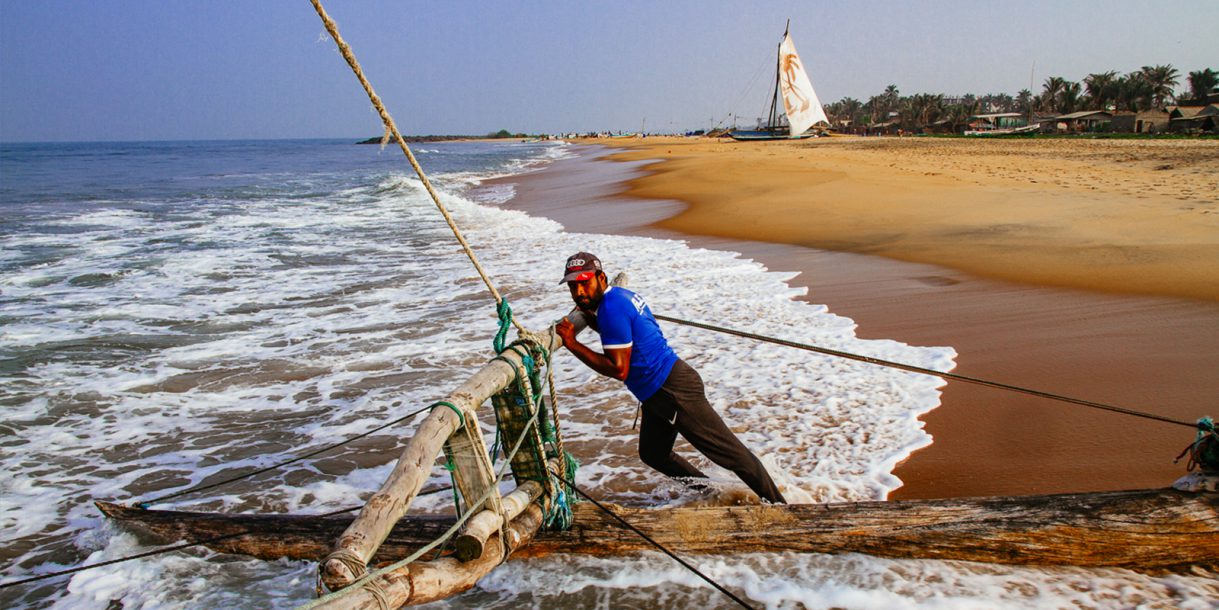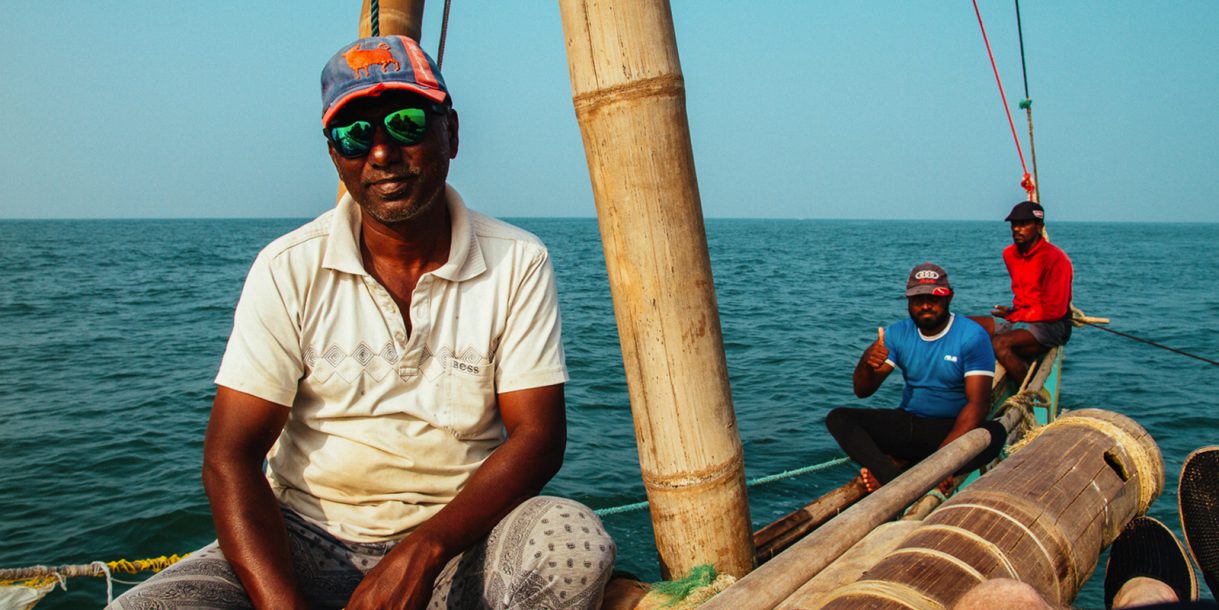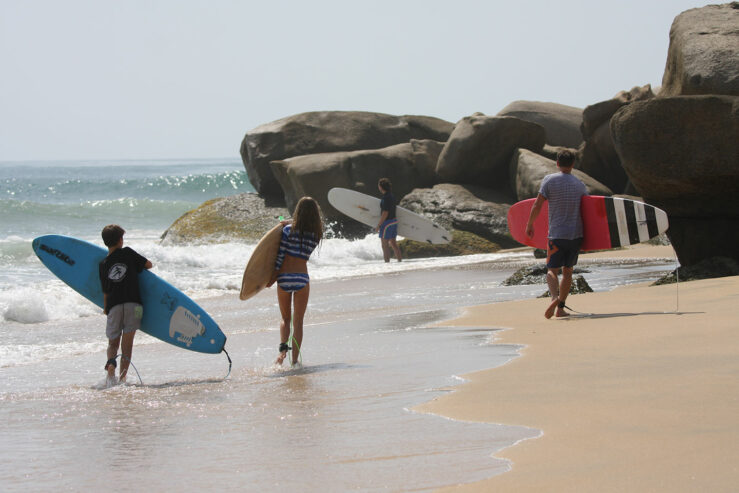Sunrise over Negombo beach. A brightening gold sky is silhouetting Jetwing Sea hotel behind me. There is an aroma of cooking spices drifting on the air. But as other guests make their way to the breakfast buffet, I’m pushing a boat into the Indian Ocean.
There are six of us putting our shoulders to the catamaran and shunting her, bit by bit, into the surf. She is a huge, heavy outrigger carved from mango wood and bamboo trunks. Thousands of these traditional boats cluster the shores of Negombo’s beaches and famous turquoise-watered lagoon.
For centuries, the ketti-maran has been the vessel of choice for fishermen in Sri Lanka, long before the arrival of the Portuguese, Dutch and British on this island. Although a dead weight on land, these boats cut through the water at a decent lick once afloat. As we push and paddle through the breakers, the breeze soon fills the square sail above our heads and we’re zipping over the swell towards the glinting horizon.

I’m on the hunt for tuna, squid, jumbo prawns, lobster and – most of all – the famous Negombo crab. I want to understand and experience a little of the Negombo fishing traditions that still provide most in this seaside community with a living. Stretching along a north-south road running up the country’s west coast, this town is only a short dash from Bandaranaike International Airport. It is a gentler way to get your bearings when arriving in Sri Lanka than the bustling capital Colombo 40-minutes drive to the south.
Negombo beach hotels have become a favourite first stop for travelers. They are lured by the promise of palm trees, golden beaches and luxury accommodation. Many understandably head straight for a lounger to relax after their journey, but Negombo’s riches extend beyond poolside cocktails and beautiful beach views. This town’s ancient rituals of sea and sail produce some breathtaking bounties for the table. If you’re a fan of fresh seafood cooked in a variety of incredible ways, there’s no better place to touchdown.
The men who supply these ocean treasures still depend largely on the skill and courage learned through years spent on the water. Fishing is clearly an art that relies on knowledge passed down through the generations. My fisherman captain for the day is Sammy. He looks pretty dapper in weather-beaten baseball cap and mirror shades, but he’s been fishing all his life. His father was a fisherman, his grandfather too.
“All my family,” he says, casually angling the rudder with his toes. Gripping the worn wood he directs us away from the palm trees and beautiful temple roofs that fringe the beach. “Rough sea is good,” he says, scanning the water. “The current picks up the crabs and puts them in the net.”
He makes it sound easy. Sail out to sea in the morning, sink the net onto the sandy bottom with some heavy rocks, and then haul in the bounty. In a day’s voyage he and his crew might drop and raise nets four or fives times, but it hasn’t always been so. Negombo didn’t suffer the extent of devastation other coastal towns did in Sri Lanka after the Boxing Day tsunami of 2004. However, the tidal wave did reset the delicate ecosystem, and prawn and crab catches around this area dropped off for several years. Many fishermen were forced to sell their boats.
“Or their gold,” laughs Sammy, flashing me his thick sovereign rings. “Fisherman love gold,” he says. “This is our money during the monsoon. When a fisherman can wear his gold, times are good. But from April to May, during rainy season, the sea is too big, too dangerous, and I have to give my gold to the bank.”

He explains that the banks swap this crab-gold for hard cash. The fishing community lives off this pawned money until the catches are big enough to buy back the family jewels. Sammy doesn’t seem overly concerned by this precarious interrelationship. I wonder if a fishing life here might be a fairly contented one.
“It is hard-earned money. Sweat and blood.” He says. “But I feel satisfied when I get home. Fisherman are honest and we care for each other.”
Out here I get a real taste of the sea. A couple of funny, fascinating hours in Sammy’s company sail by before we turn for home, riding the catamaran back through the surf and up onto the shore. Getting to know the locals on a boat ride like this is one of the best things to do in Negombo. Our trip yields no crabs, but then again, no nets were cast. Sammy’s prize catch today was always me – a traveller paying to experience life out on the boats. And, as he admits: “A good day taking tourists out pays as well as hauling nets.” I assure him that the pleasure is mine.
Later, as the sinking sun starts to turn the water fiery, I get to see real catches being landed. I’m walking on the hot, pale sand of a crescent bay a few miles further north, home to one of the many fishing villages that dot this coast. There are clusters of basic lean-to shacks on the shoreline. Children play as the men and women fix nets or lay endless rows of silver sprats out to dry on matting. This is the community spirit Sammy reveres – the fishing ‘family’ he mentioned that cares for each other.
At the water’s edge patient hands unpick lobster and small crabs from tangled nets. Crustaceans skitter across around fibreglass hulls; the men chat, smoke, and meander from boat to boat inspecting each other’s hauls. Now and then I pick out the faint fizzing sound of a returning boat’s outboard.
The biggest welcome is reserved for an elderly fisherman coming to shore in a flimsy canoe. He shouts something, waves, and then digs at the water with a paddle made from a length of bamboo. It’s hard to comprehend how he’s managed a six-kilometre round-trip to the community’s fishing grounds, but it turns out he has something worth his efforts. An iridescent pair of pincers reaches from the netting, drawing a crowd with its slow wave. Even the grand old ladies of the fishing village join the circle to study the catch: two restaurant-quality sea crabs – a prize that may well end up on ice and put on a plane to Singapore where this Sri Lankan crustacean is a real delicacy. It is a good day. I can tell that from the smiles and the belly laughs. And when each voyage out to sea is a lottery, the joy of a decent reward is heartfelt.
Back in Negombo and in front of the beautiful Jetwing Beach hotel – on the golden sands just down the coast from Jetwing Sea – I witness a very different but equally impressive catch. A man diving to the right sprawls in the sand, but holds a cricket ball aloft triumphantly. The thwack of a bat on ball is as commonplace as the sizzling pan of seafood in this crab- and cricket-mad part of the world, and this game looks like it is shaping up to be a cracker.
The locals are playing for pride before the light fades, whipping every other ball high into the palm trees in front of the hotel. I watch on smiling, impressed by their passion and talent, and feel honoured when invited to bat for an over or two before I hear my stumps fly from a wicked delivery. Only when the moon replaces the sun over the water do we all pack up and head for home.
In the morning, a walk along the same stretch of sand reveals a coloured arc of nylon curving from the beach back to shore. In the night a small boat has set a net and created a fake lagoon. By midday, men have begun a tug-of-war with the sea. From teenager to pensioner, each straps the net to a clip on a leather belt around his waist, and hauls. Step by step, metre by metre. Hours of sweat and grind in the furnace until the net gets closer to the shore with none of the haulers knowing if it contains a catch of any worth. Cuts of the bounty are divvied up depending on age, and how long each has hauled for. Some men are there from the start, others join in when the net nears the beach, when the squawking gulls swoop and dive at the water.
Then a crowd gathers at what must be a mighty treasure, and I see it too: a brown fin, large, rearing out of the water. The net owner isn’t happy about something. He jumps into a boat and skims across the surf to the thrashing beast, shouting as he does.
Then a crowd gathers at what must be a mighty treasure, and I see it too: a brown fin, large, rearing out of the water. Yet the net owner isn’t happy about something. He jumps into a boat and skims across the surf to the thrashing beast, shouting as he does.
“What it is it?” I ask.
“A tree.”

The stump is slowly pulled ashore but it has twisted the net, rendering it useless. The kitchen staff watch on disappointed. They had hoped to buy something directly from the shore to serve up that night in the restaurant. This is how the Jetwing chefs in Negombo prefer their ingredients: carried up the beach, dressed, cooked and eaten, all within metres of the sea. Never mind. For the fisherman, the chefs and me, there’s always tomorrow. Or the bustling Lellama fish market, a ten-minute drive away.
The following day I’m up before dawn to see Negombo’s biggest and busiest seafood market for myself. Our car judders through dark streets alongside Negombo’s lagoon – the saltwater inlet that is the heart of the fishing community. This is where fishermen catch the famous lagoon crab, famed for being more delicate and sweeter than its sea crab cousin. It’s here too that many sell their catches along the road. But there’s no time to stop. We need to get to Lellama before sunrise to catch the spectacle of deep-sea boats returning from their thousand-mile voyages in search of tuna and black marlin.
And what a sight. Trestle tables are laid out with aquatic silver bullion – skate fish, rows of narrow-barred Spanish mackerel. There are huge fish stacked on wooden pallets and plastic buckets piled high with gleaming shrimp being loaded into trucks packed with ice. In the sodium light of stalls, prime cuts of tuna – skipjack and yellowfin – glow crimson pink. And for those who can’t fillet their own, a skilled knife-man flashes his glinting blade, dicing, boning, and stripping the fish for a small fee. All around us, buyers from restaurants and hotels haggle beside housewives shopping for the family meal. As the sun rises above the lagoon I see smaller craft arriving with their catch, trading crab direct to the crowd from the deck of the boat.
On our return to the hotel we take a slow drive around Negombo’s old quarter to take in some of its colonial architecture. Today Negombo is perhaps best known for modernist hotels. Jetwing Lagoon and Jetwing Beach are great examples – both were designed in trademark ‘tropical modernist’ style by Sri Lanka’s master architect, Geoffrey Bawa. Yet Negombo has fascinating pockets of history too. I explored the Dutch-period canal and walked backstreets past ornate, historic and brightly lit catholic churches that have earned this town the nickname “Little Rome”.
Arriving at Jetwing Sea for lunch, I head to its open-air, thatch-roofed beach restaurant. Sweetly named ‘the Lellama’ in a doff of the cap to the fish market, it is the pride and joy of head chef Mahesh Wanniarerachchi. He had earlier promised to show me a Negombo seafood special and he duly obliges. In fact, he cooks it in front of me, whipping together a remarkable seared tiger prawn salad starter that is perfectly complimented by a mango and avocado dressing. Then he picks out an enormous, fresh langoustine, explaining how it was plucked from the waves just last night.
The sauce is layered with incredible flavours: ginger, garlic, cumin, coconut, turmeric, tamarind, and curry leaves, before the langoustine is added to create the curry. I taste it and admit that I could eat it everyday for the rest of my life and never get bored. Then, just when I think things can’t get any better, out comes the lagoon crab curry and I’m in foodie heaven.
This is exactly what I’ve been searching for. Chunks of delicately sweet and tender white meat fall from the claws; creamed coconut calms the heat of the fresh chilli with wonderful, subtle balance. It’s flavour-crammed, devilishly more-ish and absolutely irresistible, as my wiped clean bowl testifies. Be sure of this: you could travel the world looking for a crab curry as good as this, and you’d always end up back at this spot.
Crustaceans and cricket might not seem a natural combination. But when you consider how passionately people feel about both these things in Sri Lanka, it’s no surprise to learn that these two worlds have come together. This happened when two of Sri Lanka’s sporting heroes – batting partners and cricket World Cup winners Kumar Sangakarra and Mahela Jayawarendene – went into business with the acclaimed restaurateur, Darshan Munidasa. Together they opened a hip seafood restaurant in the Old Dutch Hospital in Colombo Fort, 35km away from Negombo. ‘Ministry of Crab’ is now recognised as one of the ‘World’s 50 Best Restaurants’.
Just like Mahesh and the chefs here at Jetwing’s Lellama restaurant, Ministry of Crab was conceived to celebrate the quality of Sri Lanka’s seafood. It was also to ensure that the best lagoon crabs – like the pair I’d witnessed brought ashore in a canoe a couple of days ago – don’t just end up on a plane to Singapore. Thanks to the dedication of local fisherman and Jetwing’s chefs, travellers arriving or departing from Negombo now have the chance to taste these treasures where they’re caught.
But be warned, a post-lunch lounger will almost certainly be required.

I lie down on one beside the 100m pool at Jetwing Lagoon hotel on the other side of the lagoon. This is where I’m spending my last night. As the sun sets to the west, over the sea, I think about how great my Sri Lanka holiday has been. I’ve had a unique opportunity to go beyond most people’s experience of Negombo and get to know the real people and the passions that run through this beautiful beach resort. I’ve met the fishermen, sailors, chefs, and market traders and seen the effort that goes into the supply chain, from source to table. But this all brings a moment of anxiety too. No matter where I go and eat from this point on, I’m worried I’ll never experience seafood curries this delicious again.
Then again, that’s all the more reason to return.























































